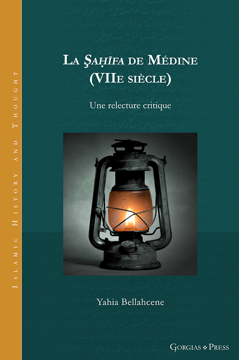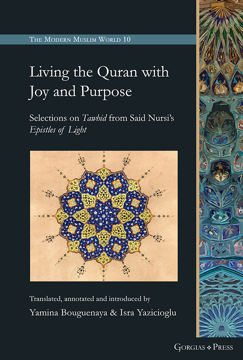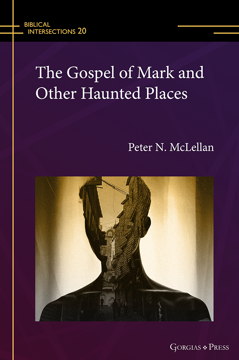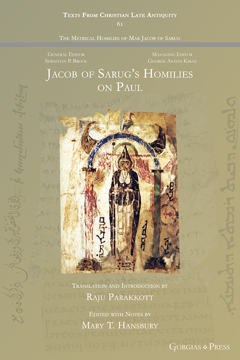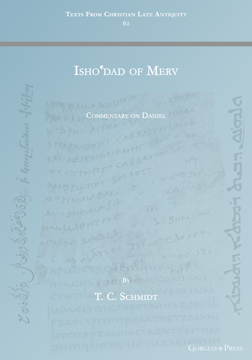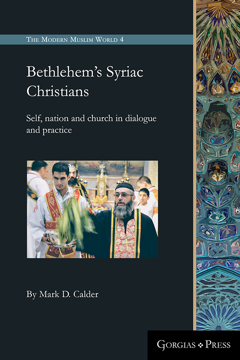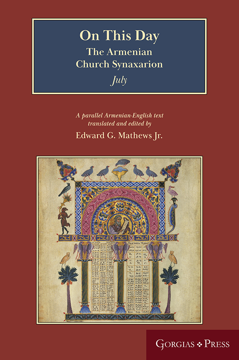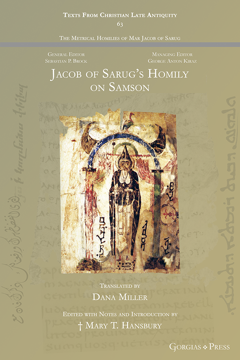La Şaḥīfa de Médine (VIIe siècle)
Une relecture critique
Series: Islamic History and Thought 25
ISBN: 978-1-4632-4268-8
The Ṣaḥīfa of Medina is preserved thanks to two 9th century historiographers: Ibn Hishām and Abū ‘Ubayd. It clearly illustrates, through variants present in both the text and its chain of transmission, the challenges posed by sources that reach us by way of oral tradition. The present study sheds fresh light on the text of one of Islam’s most important documents by investigating its nuances, as adding greater clarity to the social and political context of this challenging and important text.
$198.00 (USD) $118.80 (USD)
Living the Quran with Joy and Purpose
Selections on Tawhid from Said Nursi's Epistles of Light
Series: Gorgias's Modern Muslim World 10
ISBN: 978-1-4632-4269-5
The current volume is an annotated translation of selections from a noteworthy Muslim theologian Said Nursi (1876-1960) on the Quranic theme of oneness of God (tawhid). Given the scarcity of theological themes in Islamic literature in English as well as the lack of studies on Said Nursi, who wrote in Ottoman Turkish, the book is an important contribution to the field. It offers a contemporary peek into the view that faith in God could be profoundly meaningful and fulfilling spiritual path.
$45.00 (USD) $27.00 (USD)
The Gospel of Mark and Other Haunted Places
Series: Biblical Intersections 20
ISBN: 978-1-4632-4271-8
Euro-American biblical scholarship has traditionally conceived of the Bible in a way that removes privileged readers from personal responsibility in the subjugation of marginalized communities. Peter McLellan terms this practice gentrified biblical scholarship: readers removed from difference, because of the gentrification of space in the West, who are left without the conceptual resources to understand their relationship with the Bible as simultaneous relationship with minoritized communities. McLellan deploys the theoretical fields of hauntology and critical space theory to argue that the Gospel of Mark is a haunted place. A project written largely in New Jersey’s wealthy northern suburbs, each chapter converses with vignettes from Newark, New Jersey’s Ironbound neighborhood—a low income, largely Latinx and immigrant community—to explore relations between these two otherwise isolated locales. The result is a discussion of gentrifications harmful effects on vibrant communities, made invisible to suburban Christian readers, and an effort to explore how marginalized people make persistent demands upon those who hold Mark’s Gospel sacred.
$114.95 (USD) $68.97 (USD)
Jacob of Sarug's Homilies on Paul
On the Conversion of the Apostle Paul and a Second Homily on Paul the Apostle
Translation and Introduction by Raju Parakkott; Edited with Notes and Introduction by Mary T. Hansbury
Series: Texts from Christian Late Antiquity 61
ISBN: 978-1-4632-4273-2
Recognized as a saint by both Chalcedonian and non-Chalcedonian Christians alike, Jacob of Sarug (d. 521) produced many narrative poems that have rarely been translated into English. Of his reported 760 metrical homilies, only about half survive. Part of a series of fascicles containing the bilingual Syriac-English editions of Saint Jacob of Sarug’s homilies, this volume contains two of his homilies on Paul. The Syriac text is fully vocalized, and the translation is annotated with a commentary and biblical references. The volume is one of the fascicles of Gorgias Press’s Complete Homilies of Saint Jacob of Sarug, which, when complete, will contain all of Jacob’s surviving sermons.
$33.00 (USD) $19.80 (USD)
Isho‛dad of Merv
Commentary on Daniel
Series: Texts from Christian Late Antiquity 62
ISBN: 978-1-4632-4278-7
Ishoʿdad of Merv’s (fl. 850 AD) Commentary on Daniel provides an important witness to East Syriac exegetical technique. In it Ishoʿdad typically emphasizes an historical reading of the Old Testament above any kind of allegorical, spiritual, or even Christological interpretation. Most notable is Ishoʿdad’s belief that the Maccabees fulfilled several of the visions described in the book of Daniel, even including the Heavenly Kingdom of Daniel chapters 2, 7, and 8, and the physical resurrection of Daniel 12. These interpretations dramatically depart from most eastern and western commentators who considered Daniel’s visions to portend the rise of the Roman Empire and the advent of Christ. Ishoʿdad’s commentary is translated here into English for the first time.
$69.00 (USD) $41.40 (USD)
Ausonius Grammaticus
The Christening of Philology in the Late Roman West
ISBN: 978-1-4632-4280-0
The present volume describes the rich and complex world in which Ausonius (c. 310–395) lived and worked, from his humble beginnings as a schoolteacher in Bordeaux, to the heights of his influence as quaestor to the Emperor Gratian, at a time of unsettling social and religious change. As a teacher and poet Ausonius adhered to the traditions of classical paideia, standing in contrast to the Fathers of the Church, e.g., Jerome, Augustine, and Paulinus of Nola, who were emboldened by the legalization, then the imposition, of Christianity in the course of the fourth century. For this position he was labeled by the 20th-century scholar Henri-Irénée Marrou a symbol of decadence. Guided by Marrou’s critical insights to both his own time and place and that of Ausonius, this book proposes a hermeneutic for reading Ausonius as both a fourth-century poet and a fascinating mirror for his 20th-century counterparts.
$114.95 (USD) $68.97 (USD)
Bethlehem's Syriac Christians (paperback)
Self, nation and church in dialogue and practice
Series: Gorgias's Modern Muslim World 4
ISBN: 978-1-4632-4282-4
An anthropological study of Syriac Orthodox Christian identity in a time of displacement, upheaval, and conflict. For some Syriac Orthodox Christians in Bethlehem, their self-articulation - the means by which they connect themselves to others, things, places and symbols - is decisively influenced by their eucharistic ritual. This ritual connects being siryāni to a redeemed community or 'body', and derives its identity in large part from the Incarnation of God as an Aramaic-speaking Bethlehemite.
$60.00 (USD) $36.00 (USD)
Hugoye - Journal of Syriac Studies (volume 22)
2019
General Editor George Anton Kiraz
Series: Hugoye: Journal of Syriac Studies 22
ISBN: 978-1-4632-4283-1
Widely regarded as a premier journal dedicated to the study of Syriac, Hugoye: Journal of Syriac Studies was Established in 1998 as a venue devoted exclusively to the discipline. An organ of Beth Mardutho, the Syriac Institute, the journal appears semi-annually and will be printed in annual editions. A peer-reviewed journal, Hugoye is a respected academic source for up-to-date information about the state of Syriac studies and for discovering what is going on in the field. Contributors include some of the most respected names in the world of Syriac today.
$75.00 (USD) $45.00 (USD)
On This Day (July)
The Armenian Church Synaxarion (Yaysmawurkʿ)
Edited and Translated by Edward G Mathews Jr
Series: The Armenian Church Synaxarion 7
ISBN: 978-1-4632-4287-9
The Armenian Church Synaxarion is a collection of saints’ lives according to the day of the year on which each saint is celebrated. Part of the great and varied Armenian liturgical tradition from the turn of the first millennium, the first Armenian Church Synaxarion represented the logical culmination of a long and steady development of what is today called the cult of the saints. This volume, the first Armenian-English edition, is the seventh of a twelve-volume series—one for each month of the year—and is ideal for personal devotional use or as a valuable resource for anyone interested in saints.
$83.12 (USD) $49.87 (USD)
Jacob of Sarug's Homily on Samson
Edited with Notes and Introduction by Mary T. Hansbury; Translated by Dana Miller
Series: Texts from Christian Late Antiquity 63
ISBN: 978-1-4632-4290-9
Recognized as a saint by both Chalcedonian and non-Chalcedonian Christians alike, Jacob of Sarug (d. 521) produced many narrative poems that have rarely been translated into English. Of his reported 760 metrical homilies, only about half survive. Part of a series of fascicles containing the bilingual Syriac-English editions of Saint Jacob of Sarug’s homilies, this volume contains his homily on Samson. The Syriac text is fully vocalized, and the translation is annotated with a commentary and biblical references. The volume is one of the fascicles of Gorgias Press’s Complete Homilies of Saint Jacob of Sarug, which, when complete, will contain all of Jacob’s surviving sermons.
$38.00 (USD) $22.80 (USD)
